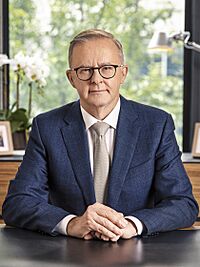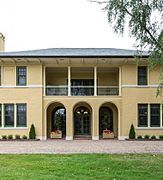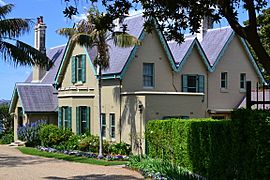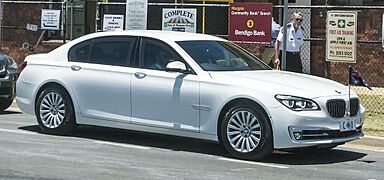Prime Minister of Australia facts for kids
Quick facts for kids Prime Minister of Australia |
|
|---|---|

|
|

|
|
| Australian Government Department of the Prime Minister and Cabinet |
|
| Style |
|
| Member of |
|
| Reports to | |
| Residence |
|
| Seat | Office of the Prime Minister, Parliament House |
| Appointer | Governor-General (according to the wishes of the House of Representatives) |
| Formation | 1 January 1901 |
| First holder | Edmund Barton |
| Deputy | Deputy Prime Minister |
| Salary | $586,930 (2023) |
The Prime Minister of Australia is like the main leader of the Australian Government. They are the head of government for the whole country. They lead a special group called the Cabinet of Australia, which makes big decisions for the country.
The Prime Minister is also a member of the Parliament of Australia and is accountable to it. This is part of how Australia's government works, called responsible government. Currently, Anthony Albanese from the Australian Labor Party is the Prime Minister. He started this job on 23 May 2022.
The Australian Constitution does not fully explain the Prime Minister's job. Instead, their role is shaped by traditions and rules from the Westminster system. This system is used in many countries that were once part of the British Empire.
The Governor-General officially appoints the Prime Minister. However, they usually choose the person who has the support of the most members in the House of Representatives. This is the lower house of Parliament. Since Australia became a nation, this has almost always been the leader of the main political party or a group of parties.
The Prime Minister gets to use two official homes. These are The Lodge in Canberra and Kirribilli House in Sydney. They also have an office inside Parliament House.
Thirty-one people have been Prime Minister of Australia. This includes thirty men and one woman. The very first Prime Minister was Edmund Barton. He took office on 1 January 1901. This was when the British colonies in Australia joined together to form one country. The Prime Minister who served the longest was Robert Menzies, for over 18 years. The shortest-serving was Frank Forde, who was Prime Minister for just one week.
Contents
What the Prime Minister Does
The Prime Minister leads the government and has a lot of power in Parliament. This is similar to other countries that use the Westminster system.
Leading the Government
The Prime Minister is in charge of the Cabinet. This is the main group that makes decisions for the government. While the Prime Minister is seen as "first among equals" among the ministers, they have the most influence.
They decide what topics the Cabinet will discuss. They also have the final say if the ministers cannot agree. The Prime Minister chooses who becomes a minister and can remove them at any time. If the Prime Minister resigns, all other ministers also resign.
The Prime Minister can also make important decisions on their own. These are sometimes called "captain's calls." They also have a big say in how Australia deals with other countries. This is because they lead the National Security Committee. This committee makes decisions that do not always need the full Cabinet's approval.
The Prime Minister also works closely with the Department of the Prime Minister and Cabinet. This department helps develop government policies. It also handles communication between different parts of the government.
Role in Making Laws
Since the 1920s, the Prime Minister has almost always been the leader of the party that has the most members in the House of Representatives. This has been either the Australian Labor Party or the Liberal Party of Australia (often with the National Party of Australia).
For the government to rule, the Prime Minister and their party must have the support of the majority in the lower house. Because political parties are very strong, most Prime Ministers can control which laws pass in this house. However, laws must also be approved by the Senate, which is the upper house. The government rarely has a majority in the Senate. This means the Senate can check the government's power to make laws.
The Prime Minister also decides when elections will happen. They advise the Governor-General on this. Elections usually take place within six months before the House of Representatives' three-year term ends.
Other Important Jobs
The Prime Minister also leads the National Cabinet. This group brings together the federal government and state leaders to discuss important issues. Even though it is called a cabinet, it is more of a discussion group. Its meetings are not secret, and decisions are not made collectively like in the main Cabinet.
Since the 1940s, the Prime Minister has chosen the Governor-General. They advise the King of Australia on who should be appointed. The King usually accepts this advice. The Prime Minister can also advise the King to remove the Governor-General. However, it is not clear how quickly the King would act in a serious situation. This was a big question during the 1975 constitutional crisis.
How a Prime Minister is Chosen
Usually, the leader of the party or group of parties that has the most support in the House of Representatives becomes Prime Minister. This party or group usually has more than half the seats. If not, they rely on support from smaller parties or independent members. By tradition, the Prime Minister must be a member of the House of Representatives.
The Governor-General officially appoints the Prime Minister. This is done under Section 64 of the Australian Constitution. However, the Governor-General must choose the person who has the support of the lower house. The Prime Minister, and all other ministers, must be a member of Parliament or become one within three months.
There is no limit to how long someone can be Prime Minister. They usually stay in the job as long as they have the support of the House of Representatives. Most Prime Ministers leave office after losing an election. They might also be replaced by their own party members. This has become more common recently.
A Prime Minister can also lose their job if Parliament votes that they no longer have confidence in the government. Or, if they fail to get enough money (supply) approved by the lower house. In these cases, the Prime Minister must either resign or call an election.
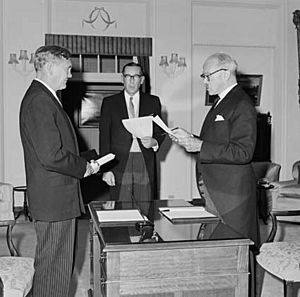
The Australian Constitution does not actually mention the job of Prime Minister by name. The people who wrote the Constitution thought the traditions of the Westminster system were well understood. Before 1901, the terms "premier" and "prime minister" were used for the leader of a colony.
If a Prime Minister resigns for other reasons or dies, the Deputy Prime Minister usually takes over. They act as Prime Minister until the ruling party chooses a new leader. This happened when Harold Holt disappeared in 1967. John McEwen became Prime Minister then.
There have been a few times when someone other than the leader of the main party became Prime Minister:
-
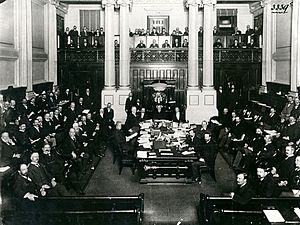 Australia's first Prime Minister, Edmund Barton, at the central table in the House of Representatives in 1901.
Australia's first Prime Minister, Edmund Barton, at the central table in the House of Representatives in 1901. - In 1901, before the first election, the Governor-General first asked Sir William Lyne to form a government. But no one would join his team. So, the Governor-General then asked Edmund Barton, who became the first Prime Minister.
- In the early 1900s, three parties had similar numbers of members. Their leaders, Alfred Deakin, George Reid, and Chris Watson, each served as Prime Minister. They lost power after losing a vote of confidence.
- In 1916, the Labor Party split over conscription. Billy Hughes was expelled but stayed Prime Minister. He led a new party with few members. Another party supported him until they merged to form the Nationalist Party.
- During the 1975 crisis, the Governor-General, Sir John Kerr, dismissed Prime Minister Gough Whitlam. Even though Whitlam's party had the most members, Kerr appointed the opposition leader, Malcolm Fraser, as caretaker Prime Minister. This led to an election, which Fraser's party won.
Since the 1970s, the change from one Prime Minister to the next has been very quick. For example, in 2022, Anthony Albanese became Prime Minister with a small team just two days after winning the election. This was so he could attend an important international meeting.
Prime Minister's Benefits
Salary
As of 2023, Australia's Prime Minister earns a total salary of $586,950. This includes a base salary that all members of Parliament receive ($225,750). It also includes an extra 160 percent for being the Prime Minister. An independent group decides how much the base salary increases each year.
Homes and Travel
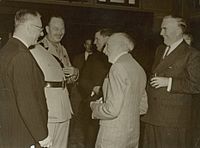
The Prime Minister has two official homes. The main one is The Lodge in Canberra. Most Prime Ministers choose to live there because it is secure and close to Parliament House. However, some have chosen differently. For example, John Howard preferred to use Kirribilli House in Sydney as his main home.
The official homes have staff, including chefs and house attendants. They are also very secure. These homes are often used for official events, like receptions for Australian of the Year finalists.
For official travel, the Prime Minister uses special transport. The Royal Australian Air Force provides an Airbus KC-30A for overseas trips. Two Boeing 737 MAX 8 planes are available for shorter flights. For ground travel, the Prime Minister uses an armoured BMW car. It is called "C-1" because of its number plate. Police vehicles escort it.
- Privileges of office
After Leaving Office
After leaving office, former Prime Ministers usually receive some benefits. These can include office space, staff help, and a special pass for travel within Australia.
Only one Prime Minister, Stanley Bruce, returned to the federal Parliament after losing his seat. Other Prime Ministers served in different parliaments or as diplomats.
Acting Prime Ministers and Succession
The Deputy Prime Minister becomes the acting prime minister if the Prime Minister is away or sick. If both are unavailable, another senior minister takes on the role.
If the Prime Minister dies, the Deputy Prime Minister is appointed Prime Minister by the Governor-General. They serve until the government chooses a new leader. This happened when Harold Holt disappeared in 1967. It also happened when Joseph Lyons died in 1939 and John Curtin died in 1945.
In the early 1900s, overseas travel took a long time by ship. Because of this, some acting Prime Ministers served for many months. For example, William Watt was acting Prime Minister for 16 months between 1918 and 1919.
Honours and Recognition
Prime Ministers often receive special honours, usually after they leave office. Many former Prime Ministers have been given knighthoods. These include Edmund Barton, Robert Menzies, and John Gorton.
Other honours, like the Order of the Companions of Honour, have also been given. These were usually accepted by non-Labor Prime Ministers.
Since 1975, former Prime Ministers have been appointed to the highest level of the Order of Australia, called Companion (AC). Those who have received this include Gough Whitlam, John Howard, Julia Gillard, and Anthony Albanese.
John Howard also received the Order of Merit from Queen Elizabeth II. This honour is a personal gift from the monarch.
One former Prime Minister, Stanley Bruce, was even made a Viscount. This is a special title in the British system.
All deceased former Prime Ministers of Australia have federal electorates (areas for voting) named after them. The newest one is the Division of Hawke, named after Bob Hawke in 2021.
Lists About Prime Ministers
- The longest-serving Prime Minister was Robert Menzies. He served twice, for a total of over 18 years.
- The shortest-serving Prime Minister was Frank Forde. He served for only one week in 1945.
- The most recent Prime Minister to serve a full term was Scott Morrison. He won the 2019 election but lost the 2022 election.
Here are some lists about the 31 people who have been Prime Minister:
- List of prime ministers of Australia
- List of prime ministers of Australia by birthplace
- List of prime ministers of Australia by time in office
See also
 In Spanish: Primer ministro de Australia para niños
In Spanish: Primer ministro de Australia para niños
- Historical rankings of prime ministers of Australia
- List of Commonwealth heads of government
- List of prime ministers of Elizabeth II
- List of prime ministers of Charles III
- Prime Ministers Avenue in Ballarat Botanical Gardens has bronze busts of former Prime Ministers.
- Prime Ministers' Corridor of Oaks in Faulconbridge, New South Wales, has a path of oak trees for former Prime Ministers.
- Prime Minister's XI (a cricket team)
- Spouse of the prime minister of Australia
- Leader of the Opposition (Australia)


